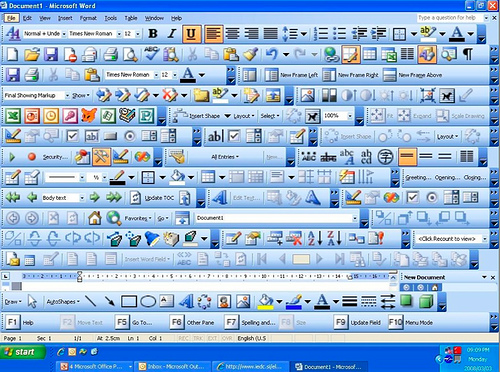Beating Feature Creep
Everybody wants their game to be the best. Because of this, it can be tempting to add as many cool features as possible. Unfortunately, this tendency can be dangerous and even kill the game entirely. In this article we learn how to avoid feature creep

The following article is a reproduction, and has been modified for this site. The original article, and many more, can be found at RemptonGames.com

When it comes to games, most people seem to believe that bigger is better. People seek out games with huge worlds, endless quests, and a massive variety of things to do and explore. At the same time, every developer seems to want to make those types of games – games that players can play for weeks on end without getting bored or leaving to play something else. For a few giant studios this paradigm may work, but for many smaller developers this mentality can lead to a number of problems down the line.
One of the biggest problems in game design, and software design in general, is feature creep. Feature creep , also known as featuritis, is tendency to want to add more and more features into the game as development goes on. These changes can vary from major gameplay additions to relatively minor adjustments such as adding an option to change text speed. These changes usually don’t seem like a big deal initially, but unless the designers are vigilant they can quickly snowball out of control.

Also known as “death by 1000 paper cuts”
Feature creep has been around at least as long as software programming, and probably far longer. However, with the current tendency towards massive “everything and the kitchen sink” games, the urge to continue adding more features can be more and more difficult to resist. However, it is also more and more important to try and resist these urges, especially in the crowdfunding space.
However, this tendency towards adding features is as dangerous as it is ubiquitous. Feature creep has led to the delay or cancellation of countless games, both from independent designers and AAA studios. There are an endless number of games that tried to do too much at once and either failed or never even saw the light of day because of it. Today, I am going to look at some strategies on how to combat feature creep in game design, and take a particular look at feature creep when it comes to crowdfunded games.
Our Feature Presentation
Know your priorities
Not all features are made equal. When trying to combat feature creep, it is important to keep in mind which aspects of the game are core to the experience and which aren’t. There is no point adding a bunch of bells and whistles if they are going to get in the way of the core gaming experience. However, it is possible that during the design process you forgot a detail or feature that is necessary to tie certain elements of the game together. If the feature is tied into the core game experience, then it is more likely to be worth adding.
The key thing to keep in mind is that you likely will not be able to add every feature to the game that you want, at least not without going over-schedule and over-budget. If this is the case, then you have to know which features are fundamental and which can be ignored if necessary.
Have a Flexible Schedule

That’s…not what I meant
A general rule with any kind of design, especially software design, is that things are going to take longer than you think. No matter how well you thought through the design of the game, there is a 100% chance that something will have to be added that you didn’t prepare for. If you establish a schedule and budget based on the initial game design, then even a small feature could result in going over-time or over-budget.
Because of this, one of the best ways to combat feature creep is to build flexibility into the schedule. Expect that new ideas will come up, and some of these ideas will actually need to be added. By building a little bit of flexible time into the schedule, you can accommodate the changes that need to be made and still complete the game on time.
Communicate clearly with stakeholders

Could you hold this for me?
For many games, the game designers are not the only people who get to make decisions. Whether it’s a publishing company trying to pressure the designers, or a brand working with the designers for a licensed game, often designers will have to take the desires of other stakeholders or clients into account. With different individuals making requests based on different end goals, feature creep becomes a much easier trap to fall into.
When working with an external client or stakeholder, there are a number of ways to go about it badly and potentially ruin your game. Firstly, you could try listening to everything they say without comment and implement every idea that they have. This may make them happy for a little while, but can result in long-term disappointment when the game comes in over-schedule, over-budget, and inevitably without all the features that were requested.
On the other hand, you can simply ignore or reject the client and stick with the very rigid earliest version of the product. However, this is unlikely to make the client very happy, and could result in them pulling funding, cancelling the license agreement, etc.
Instead, talk through potential additions with the client and decide which additions will not only work within the budget and schedule but actually make the product better. Assuming you have some flexibility build into the project, you can probably afford to add some of the features that are requested.
If the client requests something that you don’t think is feasible, talk through it with them. Try to explain why the feature would be difficult to add, and try to present possible alternatives. You can also allow them to choose between alternative sets of features – “I can get X, Y and Z done by A, but if you also want me to add V and W it might take until B”.
Keep your target audience in mind
While this is just great advice for game design and design in general, it is especially applicable when considering new features. Simply ask yourself – who are these changes for? If the change is going to make the gaming experience even more awesome for your target audience, then it is worth serious consideration.

I guess I’m just in a “visual pun” sort of mood today
On the other hand, be wary of changes with the goal of “widening your audience”. Sure, you want a lot of people to play and enjoy your game, but not at the expense of watering down the core experience. Adding features to try and bring in people who wouldn’t play your game otherwise is simply diluting the experience for your core audience, and probably isn’t going to make either group happy.
Don’t add features because somebody on the team wants to try something new
At the end of the day, games are judged solely by the player experience. There is nothing wrong with technical innovation, but only if it serves the game first. If somebody wants to add a new feature because they think it will be cool on a technical, programming level, that is probably not a good enough reason to make it into the game.
Art is never finished, only abandoned
Keep in mind that even if you really want to add something to the game, you don’t necessarily have to add it NOW. Not only can you save changes for future updates, expansions and DLC packs, but you probably should. If you plan to release future editions of your game, it’s always nice to have some great ideas in your back pocket that you just couldn’t fit into the initial release.
Feature Creep and Crowdfunding
As big as the problem of featuritis is among game designers in general, it is an especially large problem in the crowdfunding space. I don’t necessarily mean that feature creep is more common in crowdfunded games, but mostly that it is much more public and can have much more obvious consequences. To help fight this, here are some strategies specifically for crowdfunded games.
Make the game first, crowdfund second. Not the other way around.
In my personal opinion if your plan is to raise money for the game first, then make it, you are completely off base. True, crowdfunding is a way to raise money for your game but it is far more than that. Crowdfunding is about getting exposure, growing a community of fans and backers, and establishing a reputation for yourself and your company. If you attempt to fund a game without an almost-finished product, you are potentially putting all of that at risk.
As mentioned before, it can be extremely difficult to predict how long a game is going to take, and odds are it will be a lot longer than you planned. This means one of two things: either advertise an expected delivery date for the game that is very far in the future (in which case everyone will forget about you before it gets delivered), or you predict a delivery date that is too soon, which you will inevitably miss, and which will cause upset backers to wait around wondering when they are gonna get their games. Neither of these outcomes is preferable.
Be careful with stretch goals
Stretch goals are essentially formalized feature creep – if we get more money, we will do more things. For some products, such as board games, this is not too much of a problem. These games tend to use the lower cost of manufacturing from a higher number of copies to add more expensive features. This can be a very fun and economical way to encourage additional funding and reward your backers.
On the other hand, it is possible to use stretch goals as a way to spread too thin or promise too much, especially with video games. If you haven’t already developed the feature, then it is almost guaranteed to result in additional development time and delay the project. Remember – more money does not mean more time (yes, even if you hire more people).

I’ll just leave this here…
On the other hand, if you have already developed the feature, then why are you holding it hostage? For board games, those features aren’t standard because they would drive the price up. For a video game to not include those features (which are already developed and paid for) just seems mean.
More money does not mean more features
If your crowdfunding project ends up overfunding, it can be very tempting to want to add more features. Suppose you planned to make a $50,000 dollar game, but end up funding $250,000. Does this mean that your backers will be expecting a $250,000 dollar game, or that they will be disappointed with your original plan? Thoughts like these push developers to expand the game to fill the budget, resulting in rampant feature creep.
Here’s the thing – those backers decided to fund your project because they like your original plan for the game. Think of crowdfunding backers as pre-orders for a product that doesn’t yet exist. Getting too many preorders does not mean that you have to go back and change the product! In the best case scenario, adding more features means that they have to wait longer for a game that they already paid for.
Until Next Week
That is all I have for this week! If you enjoyed this article, please check out the rest of the blog and subscribe on Facebook, Twitter, or here on WordPress so you will always know when I post a new article. If you didn’t, let me know what I can do better in the comments down below. And join me next week, where I look at the topic of game knock-offs with a recent Kickstarter game!
Read more about:
BlogsAbout the Author(s)
You May Also Like







.jpeg?width=700&auto=webp&quality=80&disable=upscale)








